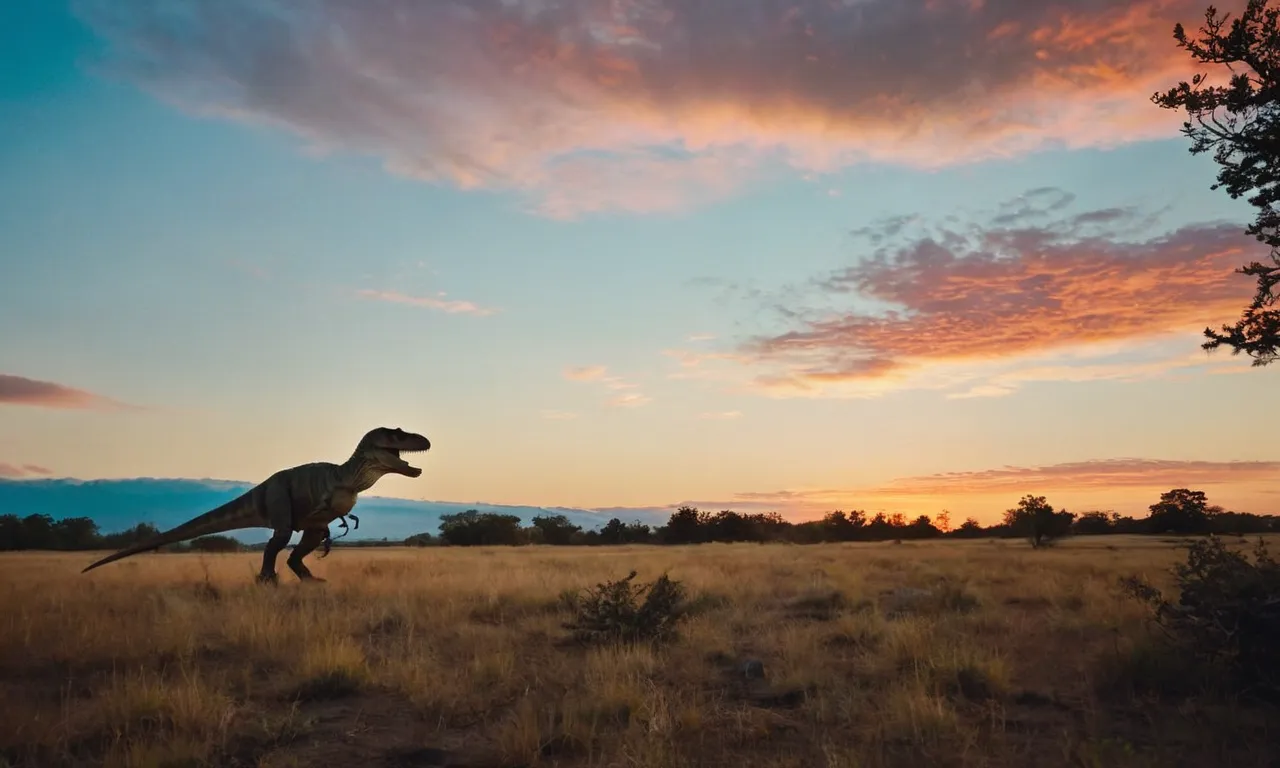When Did God Create Dinosaurs? A Deep Look At The Origins Of Prehistoric Life
For centuries, people have wondered about the origins of the majestic yet terrifying creatures we know as dinosaurs. Were they part of God’s original creation?
Or did they come onto the scene later? This question has captivated the imaginations of both scientists and theologians alike.
If you’re short on time, here’s a quick answer to your question: most mainstream Christian denominations do not take a definitive stance on when dinosaurs were created. Some believe they were part of God’s original creation, while others argue they emerged and went extinct between biblical events.
The Bible itself does not explicitly mention dinosaurs.
In this comprehensive article, we’ll dive deep into the leading theories, biblical references, and scientific evidence regarding when dinosaurs walked the Earth.
We’ll explore the Genesis creation story, Noah’s ark, the age of the Earth according to science, and how different Christian faiths have attempted to reconcile dinosaur origins with their beliefs.
Whether you’re looking to strengthen your faith or simply want to satisfy your curiosity, you’ll find a thorough examination here.
The Creation of Life in Genesis
Genesis, the first book of the Bible, provides an origin story for the universe and life on Earth.
The creation narrative unfolds over six days, with God speaking elements of the world into being – light, sky, land, plants, sun and stars, animals, and finally humans.
The Genesis account, while not scientifically literal, reveals symbolic truths about the nature and meaning of the created realm.
The Six Days of Creation
In stylized language, Genesis 1 depicts God methodically creating different facets of reality.
On each of the six days, He brings into existence some new aspect – light, oceans, dry land, plants, celestial bodies, swarms of creatures for water and air, animals for the land, and ultimately man and woman.
The sequence shows an ordered progress from simple environments to complex ecosystems and sentient beings. The refrain “and it was good” conveys the goodness of all God made.
The narrative sets up the created world as ruled by natural cycles – day and night, seasons from the motions of heavens – established at creation.
What the Original Hebrew Text Reveals
Analysis of the Hebrew original uncovers nuances in the Genesis 1 story often obscured in translation. The word for “day,” yom, allows for broader interpretations than 24-hour solar cycles, suggesting epochs of creation.
God as the opener and separator of domains matches His characterization in later scriptures as divider, judge, and cultivator of order from chaos.
The text also employs rhythmic, parallelistic structures, conveying the artistry and ritual purposes of the priests who likely formulated the oral traditions behind the written account.
Where Do Dinosaurs Fit in?
Dinosaurs and other prehistoric creatures likely correspond to the “living creatures” (nephesh chayyah) God makes on the fifth and sixth days.
While the Genesis account abbreviates the development of life on Earth to schematic “days,” the geological record reveals the fantastic scope of prehistoric biodiversity and extinction events preceding human dominance.
Yet both secular science and Biblical faith converge on seeing a special status for the human creature, the only one made in God’s “image” and granted stewardship responsibility.
Whether dinosaurs dwelt alongside Adam or had long preceded him, humans inherit a world still bearing the grandeur of bygone eras, a world both ancient and continuously renewed.
Dinosaurs in the Time of Noah
Could Dinosaurs Have Been on the Ark?
The discovery of dinosaur fossils raises an intriguing question for Christians who believe the biblical account of Noah’s ark. Could dinosaurs have been on the ark? Let’s take a thoughtful look at this possibility.
According to Genesis 6, Noah was instructed to build an ark that was 300 cubits long, 50 cubits wide and 30 cubits high. Estimating a cubit as 18 inches, this would equate to an ark about 450 feet long, 75 feet wide and 45 feet high.
While certainly large by ancient standards, could such a vessel contain a pair of every land animal species, including dinosaurs?
Skeptics claim that dinosaurs were too large or too numerous to fit on the ark. However, research by creation scientists suggests that dinosaurs came in a variety of shapes and sizes.
While some dinosaurs like the massive Brachiosaurus were clearly enormous, others were small horse-sized or even chicken-sized creatures.
Rather than taking every dinosaur species, Genesis says Noah took ark-worthy animals “according to their kinds.” This may refer to taking pairs of smaller dinosaur types rather than the largest specimens.
Dinosaur Fossils and the Biblical Flood
If dinosaurs were on the ark, why are their fossils found throughout the world mixed with fossils of other creatures in sedimentary rock layers? This is explained by the global Flood described in Genesis 7-8.
Creation scientists believe the Flood provided ideal conditions for forming the fossil record we see today.
Rising floodwaters buried and preserved organisms in mud and sand that later hardened into sedimentary rock. The catastrophic nature of this inundation also explains why dinosaur fossils are often found jumbled together with other species.
As the Flood overwhelmed ecosystems, organisms were uprooted from their environments and redeposited with others in distant locations.
While localized floods do not have the power to accomplish this on a global scale, the year-long Genesis Flood provides a convincing explanation for widespread mixing of dinosaur fossils.
These creatures were buried rapidly by Flood sediments rather than slowly accumulating over eons of time.

The Age of Dinosaurs According to Science
Dinosaur Fossils and Geological Strata
The age of dinosaurs is primarily determined by the fossil record and the geological strata in which dinosaur fossils are found.
Paleontologists have discovered dinosaur fossils in sedimentary rock layers dating back to the Triassic period over 230 million years ago.
The dinosaurs proliferated and diversified during the Jurassic period around 200-145 million years ago and dominated the earth during the Cretaceous period 145-66 million years ago until their extinction.
The geological timescale and chronological order of these rock layers establishes the timeline of dinosaur existence.
The farther down the layers, the older the rocks and any dinosaur fossils they contain, allowing scientists to date the age of dinosaurs.
Radiometric Dating of Fossils
In addition to geological strata analysis, radiometric dating of volcanic ash layers and igneous intrusions associated with dinosaur fossil beds provides numeric age data for dinosaur specimens.
Radiometric techniques like potassium-argon, argon-argon, and uranium-lead dating can accurately date volcanic rocks and ash trapped in the same sedimentary layers as dinosaur fossils.
Volcanic episodes are excellent time markers. Radiometrically dated ash deposits definitively pin down the age of many crucial dinosaur fossil finds.
For example, argon-argon dating has reliably dated ash associated with the famous Tyrannosaurus rex specimen “Sue” to an age of 67 million years.
The Mesozoic Era and the Age of Reptiles
The Mesozoic Era spanning 252-66 million years ago is also known as the Age of Reptiles because reptiles dominated both marine and terrestrial ecosystems during this timespan.
The Triassic, Jurassic, and Cretaceous periods of the Mesozoic comprise the age of dinosaurs as increasing diversity and gigantism of dinosaur species peaked during this era.
While the earliest dinosaur fossils date back into the late Triassic period around 230 million years ago, the Jurassic and Cretaceous epochs saw the emergence of dinosaur behemoths like Brachiosaurus, and predator giants like Tyrannosaurus rex right before the dinosaurs went extinct around 66 million years ago at the end of the Cretaceous.
Attempts to Reconcile Science and Scripture
Examining Biblical Hebrew Words and Context
Some scholars have examined the original Hebrew words and context in Genesis to gain insight into how to interpret the creation account.
For example, the Hebrew word “yom” translated as “day” could also mean an indefinite period of time rather than a 24-hour day.
Looking carefully at the language allows room for interpretations other than 6 literal 24-hour days.
Treating Genesis as Allegory Rather than Literal History
Many theologians treat the early Genesis accounts as allegory, poem, or metaphor rather than a literal scientific history.
This view holds that Genesis reveals theological truths about God and humanity’s relationship to him, not scientific details about material origins.
Therefore, science and scripture do not directly conflict when properly understood. Treating early Genesis as allegorical is a mainstream view in many theological traditions.
Two Separate Creations with a Gap in Between
Some attempts to reconcile science and scripture propose that there were two separate creation events with a gap between them. Genesis 1 refers to an initial creation event, while Genesis 2 jumps ahead to describe a much later, second creation after life on Earth was destroyed and became “formless and void.”
This allows for mainstream science fitting in the long gap period.
While the gap theory is not widely held today, it shows the creativity exegetes apply to harmonize science and scripture. The diversity of interpretations itself shows the complexity of deriving definitive claims about ancient texts.
Conclusion
The question of when dinosaurs roamed the Earth continues to fascinate both religious and scientific minds. While the Bible does not provide a definitive timeline, insights can be gained by closely analyzing the original Hebrew text and contextual clues.
Mainstream science points to a Mesozoic Era spanning millions of years, while creationists argue for a much younger age based on their reading of Genesis. With an open and inquisitive perspective, we can thoughtfully consider how the ancient past might align with our faith.
As we unravel the mysteries of prehistoric life, we marvel at both the natural wonders and divine origins of this world.








